Gothic punk alternative shopping in London, England! Camden Market Cyberdog, hipster Shoreditch fashion.

London calling! If you’re planning to travel to the English capital, this shopping guide is for you.
Read on for a comprehensive Goth / punk/ hipster tour of London’s most alternative districts, Shoreditch and Camden!
I was overjoyed to reunite with my long-time friend Kat Williams of Rock n Roll Bride (we went to Prague together years ago).
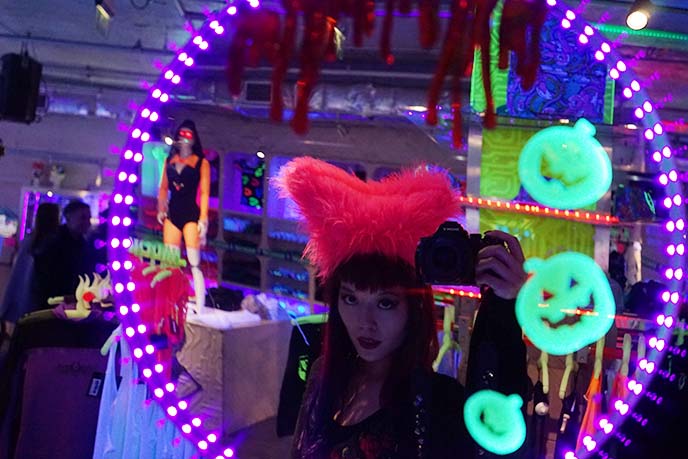
We spent the day exploring two of London’s “youth culture” neighborhoods: Camden Market (Gothic punk rave) and Shoreditch (hipster and artistic).
If you’re in a shopping mood, this post comes at a good time because…

It’s Black Friday and Cyber Monday! From Nov 24-27, there are major sales on Gothic / alternative / kawaii clothing online. If you love dark fashion, I’ve rounded up some of the best deals for you.
❤ Some of my favorite Goth clothing brands — Disturbia, Killstar, Iron Fist, Valfre and Morph8ne — are currently having sales! (Click these names to see.)
You can also find tons of discounts at the following sites. Just check out the URLs below:
❤Dolls Kill ❤ Amazon ❤ Hot Topic ❤ Kat von D ❤ Sephora ❤Etude House ❤ Valfre
Feel free to share / re-post this to let your friends know!
Here’s a compilation of my favorite items. For details on these Iron Fist goodies, click the thumbnails:
If you’re a fan of Killstar – there are lots of sale prices here…

Morph8ne – click for reductions.
Disturbia – #blackfriday #cybermonday promo codes below, and more here. Have fun!

Here’s another version of my outfit of the day (shot in my apartment; more photos of my home here.) My skull and roses Gothic sweater is by Jawbreaker Clothing. The light knit keeps me warm, and the Gothic embroidery design truly stands out!
I paired it with After Hours No Tongue knee-high leather boots by Sorel Footwear (this style comes in both redwood and black.)

Now, back to my alt shopping guide of London UK. Kat and I started in Camden Market, the long-time hangout of British punks, Goths, metalheads and other alt youths.
To get here, take the tube (subway) — Northern Line to Camden station — and walk outside. You’ll immediately come across all sorts of alternative stores (such as the Gothic Lolita boutique, Sai Sai) and Camdenlock (where I stopped for a shot of fresh orange juice).

The vibe reminds me of St Mark’s Place in NYC, but larger (there are over 1000 stores). I first visited Camden over 10 years ago, and was mesmerized by the scene. Today, this remains the go-to place for tattoo and piercing parlors, and dark fashion.

The storefronts are creatively decorated with giant shoes, elephant heads, dancing girls, and even a dragon that appears to be twisting around a building.

New Rock has a shop, with an entire wall displaying hardcore stomper boots and leather shoes.

London was one of the earliest centers of Goth and punk subculture, with bands like Siouxsie and the Banshees, The Damned, Alien Sex Fiend, and the Sex Pistols. These influences live on in various parts of the cities, but especially Camden Lock.

Camden is also a wonderful place for food, with lots of small stands selling ethnic cuisine, sweets, and creative takeaway. Kat and I saw a man at a Chinese fast food station, joyously singing “I’m a Barbie girl!”
When I visited, I encountered the Stranger Things pop-up food truck, which doled out fresh waffles. The lineup was too long, so I went around the corner and got a fresh ginger-lemon-honey drink that hit the spot.

Camden’s alt stores differ in quality. The main streets mainly have inexpensive souvenirs, so we gravitated to the smaller, inner alleyways. Here, you’ll find beautiful handmade goods such as this peacock feather neckline. Many of the shops are run by the designers, giving you a chance to meet them and make a custom order.

The shops are constantly changing around, but there’s always a great mix of underground styles. I snapped these photos at Tainted Prince, a Victorian / steampunk / elegant Gothic aristocrat / kodona dressmaker. Kat and I also went inside a few K-pop streetwear and vaporwave / Tumblr aesthetic boutiques.

My favorite Camden store remains Cyberdog, which seems to contain an entire universe of futuristic fashion.
Cyberdog blasted off in the 1990s, and continues to innovate with rave clubwear and high-tech accessories. The mothership (and largest store) is this one in Camden Market, located in a building that was once the living / rehearsal space of punk band The Clash.
(Cyberdog address: 842 Chalk Farm Rd, London NW1 8AH, UK)

Inside, you feel like you’ve stepped into a scene from the Hackers movie. Two floors of clothing, jewelry, shoes and toys, lit up with neon lights and pumping with the sound of EDM.
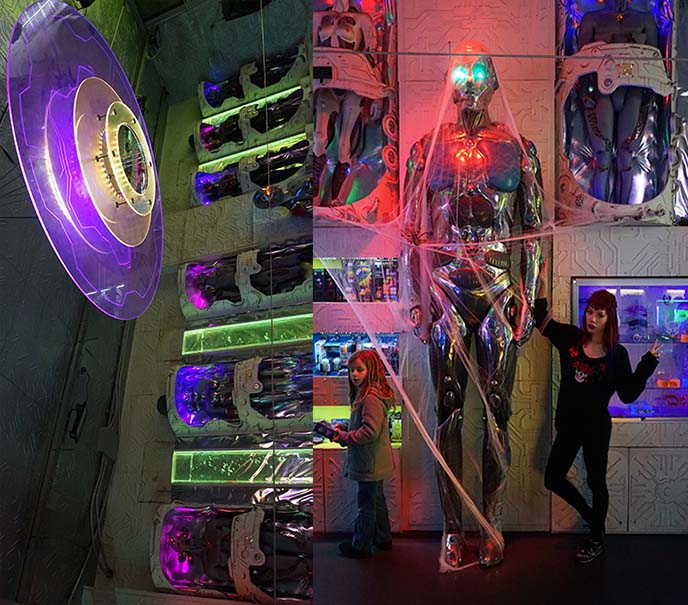
The space was decorated with cobwebs and other Halloween elements for “Cyber-Ween.” I imagined I was being abducted by the UFO, and posted with the giant robot with flashing green eyes.
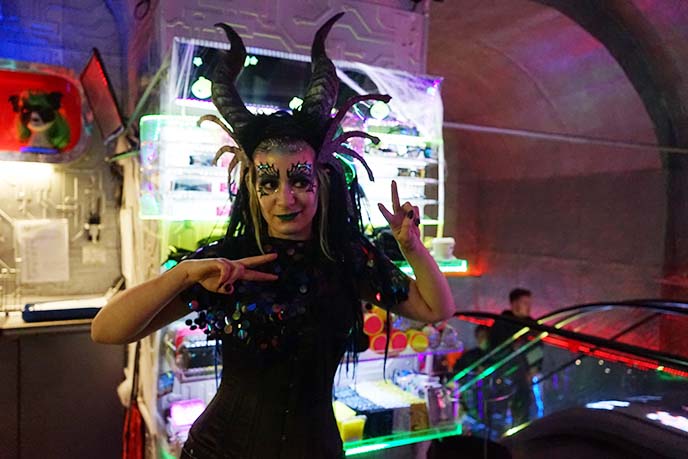
I was blown away by the staff’s attention to detail — their makeup and fashion skills were A++. The store goes all out to maintain an immersive sci-fi environment. Note the escalators with flashing rainbow lights and moving 8-bit characters!

True to its concept, many of Cyberdog’s designs creatively incorporate futuristic components. These include space-age fabrics (florescent, holographic) and tech (flashing lights, electronics, LEDs). On this wall, you can spot my light-up mini backpack.

The sweet staff illustrate two of the many looks you can put together at Cyberdog. Whether you’re into Goth, Industrial, rave clubwear, Burning Man, flower child… there’s something unique to be found.
(The store also has relatively “normal” shirts with the mecha-devil-alien logo, for those who are less experimental dressers!)
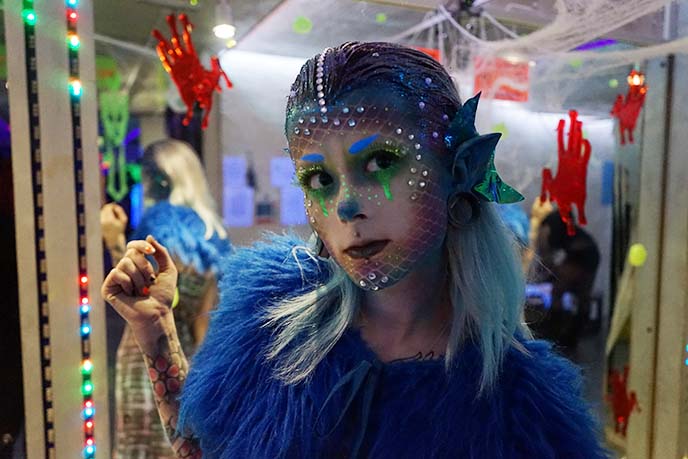
I first visited Cyberdog about 10 years ago (when it was in a smaller Camden location), and was delighted to see the brand maintain its subculture roots. The staff welcomed me enthusiastically, and I could tell they were truly passionate about underground music and lifestyles.
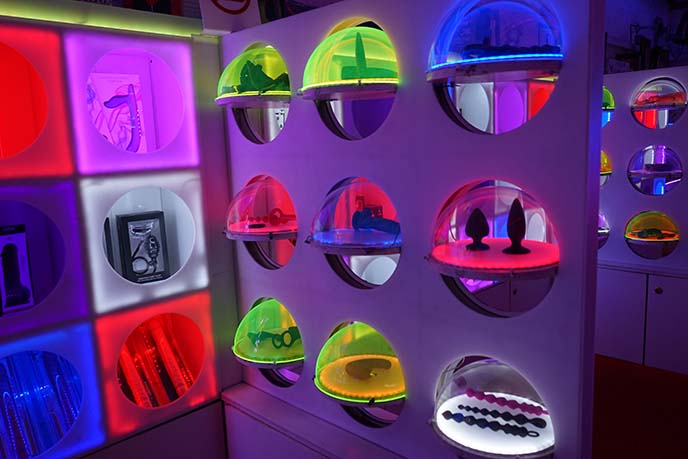
The Camdenlock store is immense — I felt like I was exploring an extraterrestrial city. One section is adults-only, and dedicated to Cyberdog’s “Futurelovers” brand. Launched in 2012, it sells sex toys and fetish clothing (displayed in what appear to be alien pods!)

It’s amazing to see how much Cyber Dog has spawned, from a small Camden Market stall in 1994. The founders, designer Terry Davy and business manager Spiros Vlahos, named the label after their pet chihuahua, “Chichi the Cyberdog.”
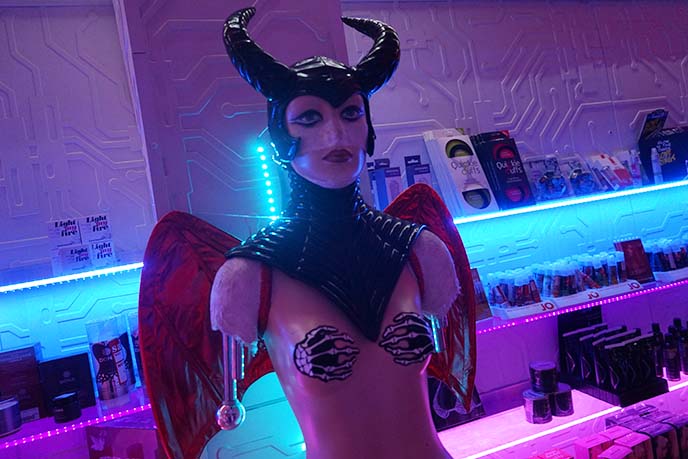
The rave days of the 90s are over, but electronic / club music continues to evolve and thrive. Today, EDM festivals like Ultra are held worldwide, and Burning Man attracts record numbers. I’m personally loving synthwave (future 80s synth sounds) — this devilish headpiece would be perfect for a Perturbator concert.
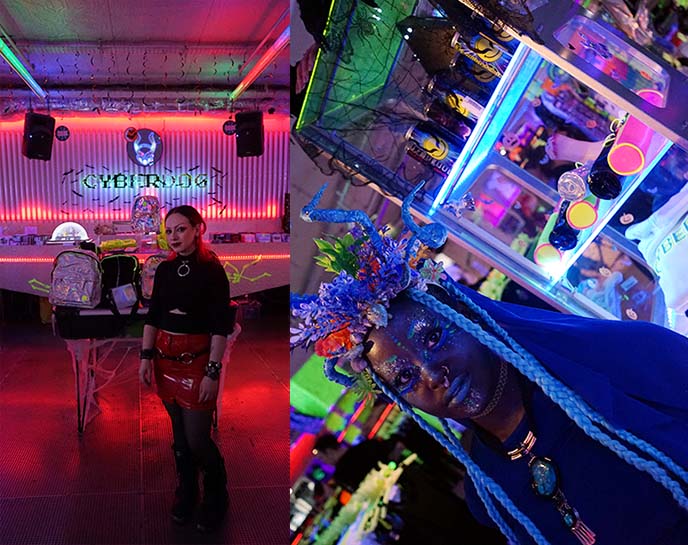
From goggles to vinyl skirts and O-ring necklaces, the company has a huge selection of items. You can shop for everything from Cyberdog’s website (I remember ordering from their site in the early 2000s!)
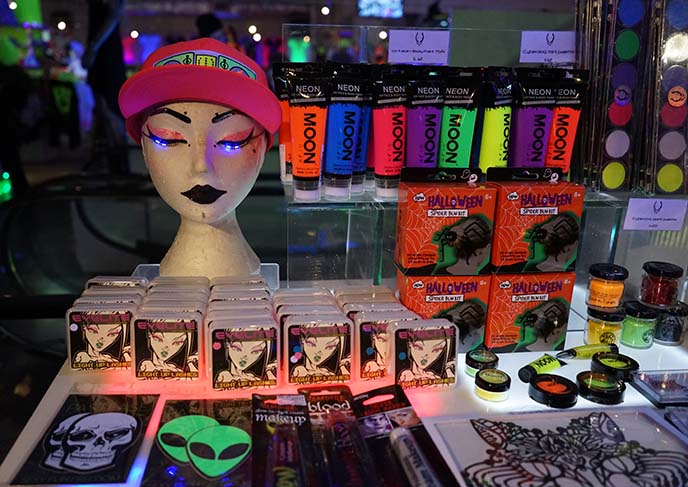
Cyberdog keeps a pulse on the latest beauty trends, such as glow in the dark makeup, and LED false eyelashes.
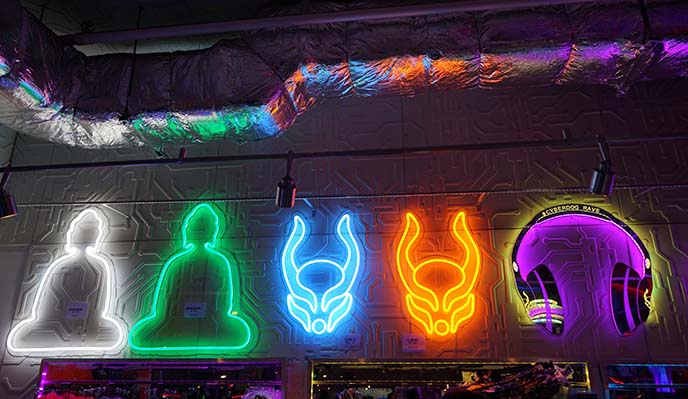
There’s a section for home goods too, and gifts from the year 3000.
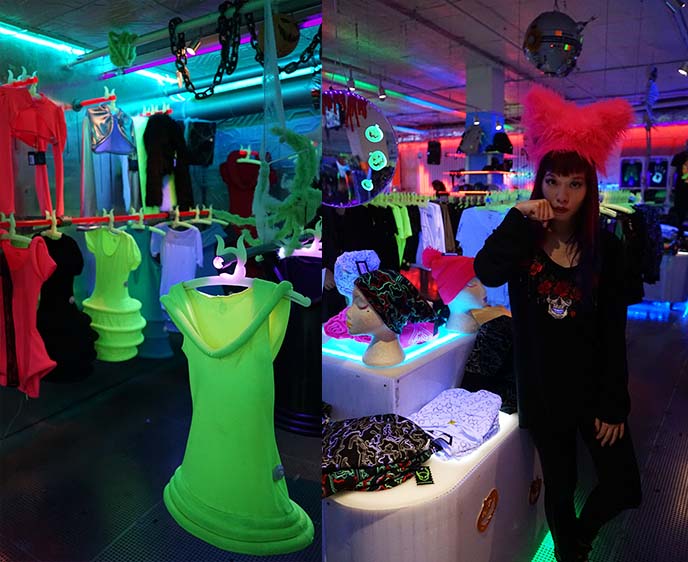
I could see the Jetsons in these intergalactic dresses. And how about this fuzzy pink hat?

There were even live Industrial / club dancers in the store… and I wonder what those robotic arms can do.
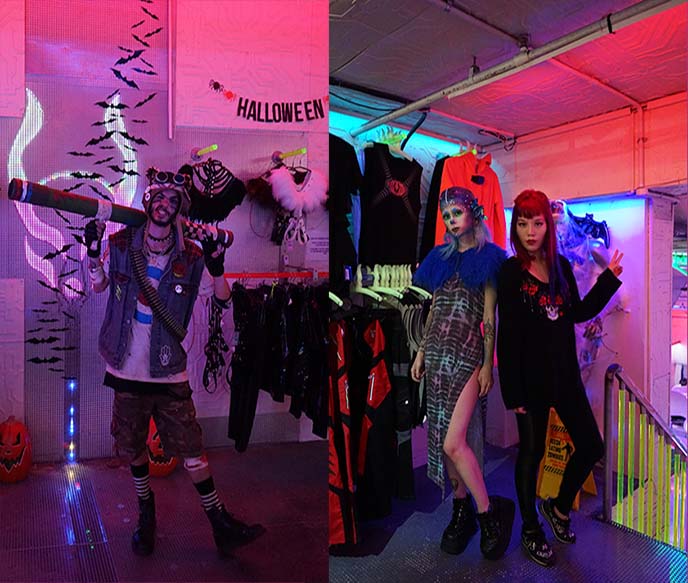
If you’re in London, ride a rocketship to Cyberdog. Their Camden Market store is full of eye candy, and lets you dress (and feel) as if you’re in outerspace.

The shop is easy to find: just look for these two silver robots guarding the entrance!

Kat then took me to Shoreditch, which has become London’s “hipster neighborhood” in recent years. Quite a few alleyways are emblazoned with colorful murals.
To get here, take the overground to Shoreditch High Street, or take the London Tube to Aldgate, Bethnal Green or Liverpool Street and walk.

Shoreditch is the place to go if you’re into indie and vintage shopping. We admired minimal jewelry, and ducked into a Halloween charity shop. Kat and I couldn’t resist snapping a photo of these spooky donuts by Dum Dums Donutterie (I spot a ghost, Frankenstein’s monster, spider, and zombie eye).

Be sure to stop by Boxpark, a retail complex made from shipping containers. There are lots of hip boutiques and pop-ups here, including The Ordinary (inexpensive science-based skincare). Kat’s holding a pink bag from Skinnydip, the London soft grunge / pastel cute brand (below is more info):

Located in the East End, Shoreditch has an eclectic, artsy feeling. You can find lots of ethnic food here, including a row of Indian curry houses that all claim to have won a “best of London” award.

I was impressed by the street art that runs through Shoreditch. Many of the works have an ear to politics, such as this S&M commentary on “Mistress May.”
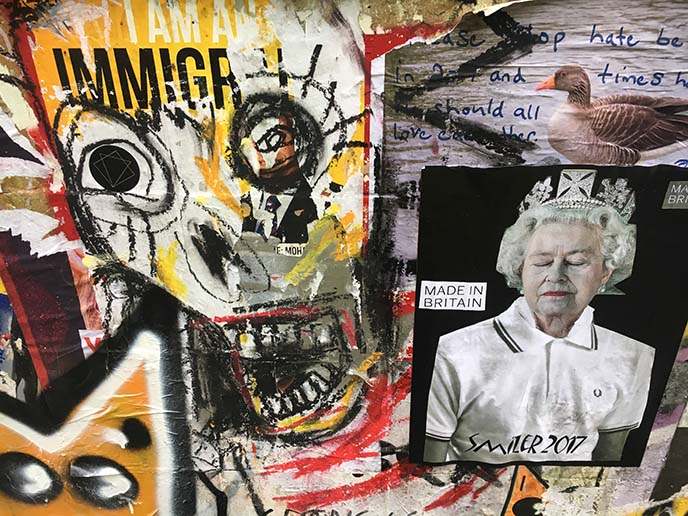
“I am an Immigrant” sits next to the Queen of England.

Young Brits have been pondering “Brexit?” ever since the unexpected vote to leave the EU. It’s fascinating to see the notes and art, scrawled in response to these current topics.

I’ll have to come back soon to spend more time in this vibrant neighborhood. I left before a taste of Shoreditch nightlife, but noticed some original themed bars (a circus-themed one, and a Ballie Ballerson ball pit).

V-fingers for a fantastic day with Kat! (I paired my Jawbreaker Clothing skull and flowers wide-neck sweater with a leather biker jacket.)

If you haven’t heard of Kat’s website, Rock n Roll Bride, you’re missing out. She features alternative weddings from around the world, from Victorian to glam rock. It’s the ultimate resource for anyone planning an offbeat wedding (or simply looking for inspiration), and also features Kat’s travel, lifestyle and fashion adventures in different countries. Kat also publishes Rock n Roll Bride print magazine, which we spotted in WHSmith and other British newsstands!
More from London to come — for now, here’s my previous Goth guide to London.
❤ And don’t forget to shop those Black Friday / Cyber Monday deals while they last!
❤ If you don’t know where to start, try Dolls Kill — and here’s a compilation of my top sales picks.
SHARE & COMMENT
Dance with the Dead: synthwave band tour review! Auxiliary Magazine cover model, Switzerland Chillon castle.

Now that I’m back from Europe, it’s time for one of those “catch up” posts… featuring a magazine cover, winter outfit ideas, and a synthwave show!
First, I’m honored to be on the cover of Auxiliary Magazine. Thank you to the brilliant team that made this “pink hair and panning for gold” look come to life. It’s fun to play around with dramatic styles for magazine modeling. (Photography by Patrick Parenteau, makeup by Jennifer Little, hair by Stephanie Hoy.)
Auxiliary Magazine’s Fall 2017 issue is available here now, in both print and digital publications. There’s a full editorial and interview with me inside, as well as plenty of alternative music, fashion and lifestyle stories that I think you’ll find inspiring.

Now, let’s chat about what to wear in winter. I have a few new cold-weather clothes that I’m excited about.
Knee-high leather boots are perfect for the season, as they give any outfit a bit of edge. I’m going to live in my new lace-up boots by Sorel Footwear (this style comes in both redwood and black.)
Sorel’s After Hours No-Tongue tall boots are made from supple yet waterproof leather. There’s a cute wedge heel that is comfortable for walking, and the sole has a strong tread.
(My silver geometric barrettes are Hair DesignAccess by Sylvain Le Hen, designer of luxury and avantgarde hair accessories.)

I’m wearing these dark red boots from Sorel Footwear’s latest collection. They have “no tongue” down the middle for a peek-a-boo effect; I like to emphasize the cut-outs with fishnets or patterned / colored stockings.
Sorel’s shoes are stylish and modern, yet made to withstand winter conditions. I’m a fan of the romantic lacing all the way up the front, for a ballerina or corset effect. (There’s also a zipper on the side, so you can easily slip the boots on or off without unlacing them.)
The designer also makes an After Hours ankle boot, and a tall black boots style. Click below for more styles:

I’m a fan of Sorel, as they deliver both form and function — I walked through rainy streets and danced all night in these shoes! My After Hours tall boots come in both redwood and black here.
I paired them with a Joy Division skirt, black fishnets, and a sweatshirt by Akade Wear (many more photos further down).

I wore this outfit to see Dance with the Dead, one of my favorite retrowave / synthwave artists. They’re currently on tour in North American with GosT (another fav, who sadly didn’t make it to the Vancouver concert).
The show at The Venue began with two impressive opening acts. My friends and I found ourselves moving to the synthy melodies of Oceanside85, and DJ Black Ultra / Amduscia.

Headliners Dance with the Dead (DWTD) are known for incorporating spooky visuals in their shows. The background lit up with a slightly creepy clip of four women singing Mr Sandman (The Chordettes, from 1958).
Then, Justin Pointer and Tony Kim strutted on-stage and launched into deadly guitar riffs — accompanied by projections of ghouls with flickering eyes!

Dance with the Dead is synth-wave with a retro-horror bent. Think head-banging metal meets dance melodies, wrapped in the electronics of the 1980s… If you’re a fan of Stranger Things, then you’ll instantly recognize the sound of “outrun.”
The band performs with high energy, switching between guitars and synthesizers. The audience jumped around with DWTD, and even formed a moshpit in the front-center.

Dance with the Dead thrilled us with upbeat tracks from their albums, “Near Dark” and “The Shape.” The set list included remixed versions of “Andromeda” and “Invader,” and a cover of Metallica’s “Master of Puppets.”
I put together a few video clips from the show, so you can see and hear the group for yourself.

Between songs, DWTD broadcast clips from old movies that influenced their sound and vision. I spotted Bride of Frankenstein, Psycho, Legend, and 1980s sci-fi and horror films.
As I mentioned in my Perturbator show review, synthwave has gotten me excited about concerts again. The “future-80s” sound is fresh, and the acts are spectacular live. Can’t wait to see more of these bands soon.

Here’s a second version of this “winter outfit of the day,” which I wore in Switzerland. This time, I paired my rocket-ship sweatshirt with leggings (both are by Akade Wear, a label inspired by synthwave — hence the pink-blue 80s vibe.) My black Goth beanie / skullcap is by Long Clothing.
I’m all about metallics right now, and love the look of a silver puffer jacket. I got mine in Romania (it’s by Cato, and not available outside the country) — but you can shop similar puffers below.

After my press trip with Experience Bucharest, photographer Joey Wong and I took a weekend jaunt to Switzerland. We flew to Geneva, then traveled by train on a First Class Swiss Travel Pass from Switzerland Tourism.
These passes let you take unlimited trains, buses and boats throughout the country, so we were keen to see as much as we could. We traveled about 1.5 hours to the fairy-tale Château de Chillon, located on an island in Lake Geneva between Montreux and Villeneuve.

I need to wear sunglasses (by Balenciaga) to look at my bag… because it lights up with LED rainbow patterns!
This rave-tastic backpack is by Cyberdog, the futuristic clubwear brand that I recently visited in London.
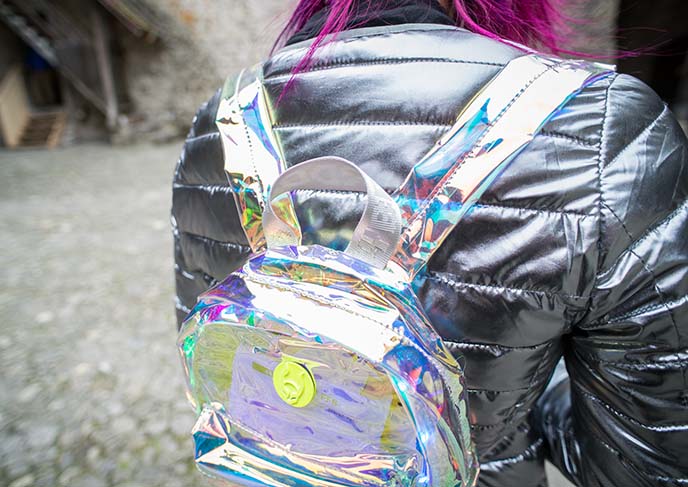
Cyberdog’s mini backpack features several light-up modes (you can display various colors and patterns at the click of a button inside). This little satchel is perfect for clubbing and festivals, and charges up with a USB cable. The backpack comes in three semi-sheer colors; I have the iridescent holographic one.
I posted an Instagram video of my Cyberdog backpack, and it went viral with over 550,000 views… talk about the future of fashion!
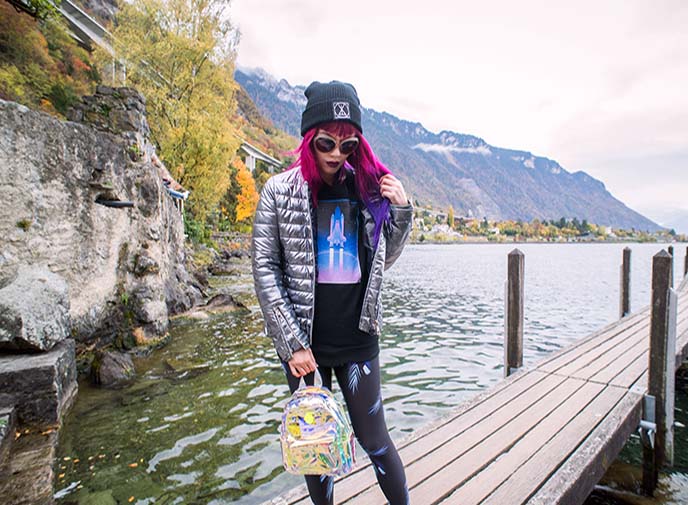
The backpack was ideal for a day-trip to Chillon Castle. We took the train from Geneva to Montreux, and then hopped on a bus for a quick ride to the chateau.
From the pier, you can take in the beauty of the Alps, the mountain range that crosses through Switzerland.
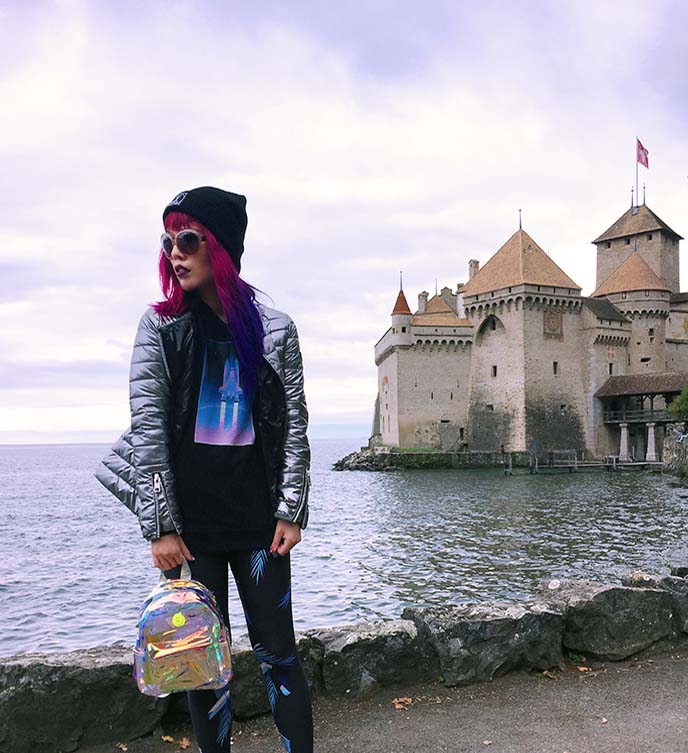
Europe is famous for its fairytale castles, and Chateau de Chillon is one of the most lovely. With our Swiss Travel Passes, we had access to hundreds of museums and historical sites — meaning we could walk straight in and explore.
So shiny, so chrome. I love the space-age look of a metallic puffer jacket! I’ve rounded up my favorite silver coats below; click the thumbnails to learn more.
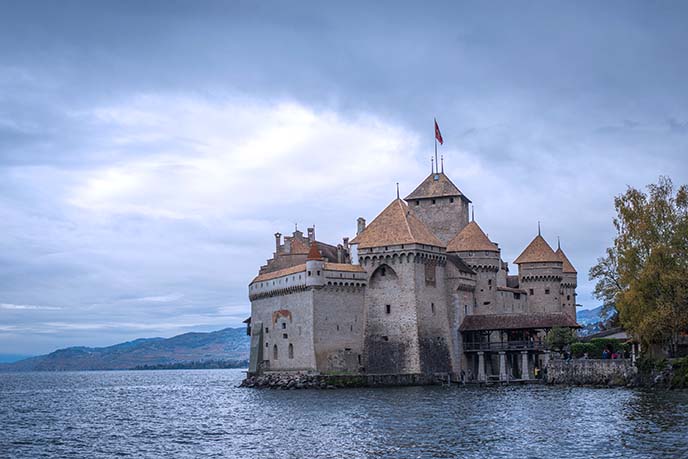
Chateau de Chillon is an ancient fortress, with the first written record dating back to the year 1005. In the 16th century, the Savoy rulers used the castle to house prisoners. The dungeon inspired Lord Byron to write his famous poem, “The Prisoner of Chillon.”
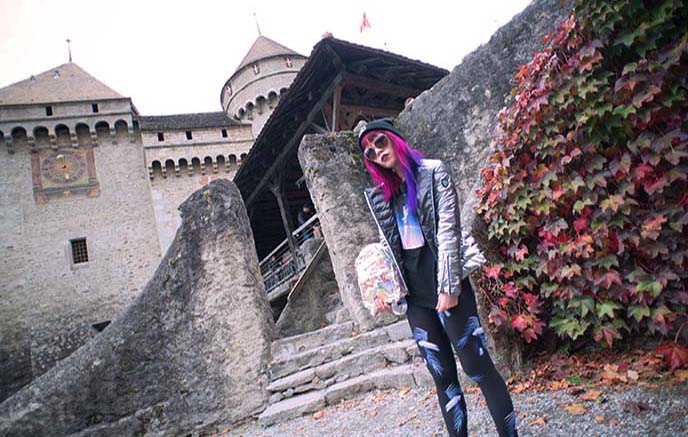
Chillon Castle consists of 25 buildings and three courtyards, protected by two circular walls. If you’re a history buff, it’s well worth coming here for a day (and also enjoying Montreux, the nearby resort town.)
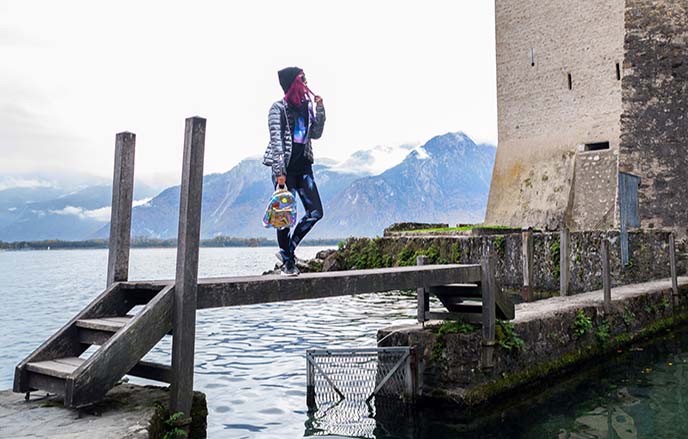
Mary Shelley was inspired to write “Frankenstein” during her stay at Chillon castle — so there’s a Goth horror side to it too!
Can’t get enough of the Swiss mountain landscapes, and Lake Geneva’s clear waters.

Close-up on my 1980s-style spaceship Horizon top by Akade Wear, and my silver winter jacket.

What do you think of my synthwave / retrowave inspired winter clothing? I hope these outfits give you some ideas for ways to stay warm while rocking a retro-future aesthetic.
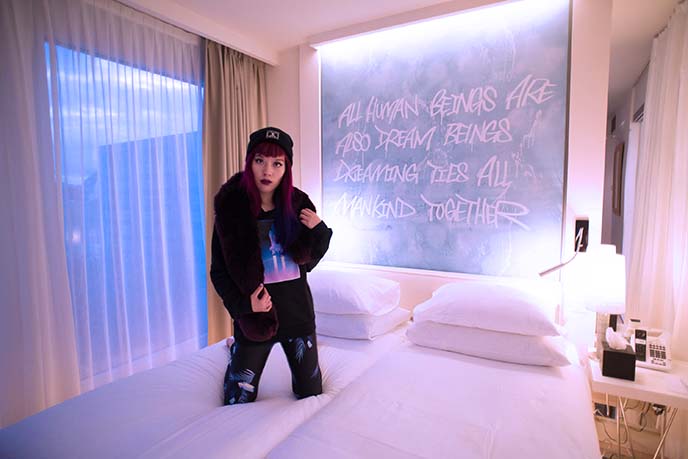
Back to Geneva, and time to chill out at Hotel N’vY. Part of the Manotel group, N’vY is in a convenient central location (a quick walk from Geneva Station, which is only a seven min ride from the airport).
I always gravitate towards art / design boutique hotels, as they are local-run and have a quirky personality. You won’t find an inspiring room like this one in a standard chain brand.
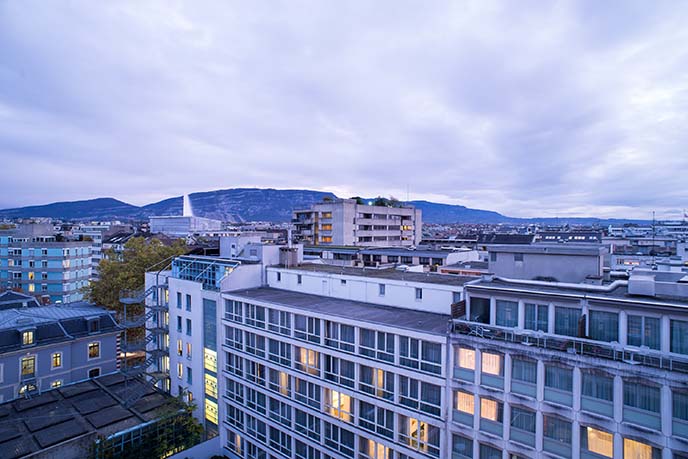
Hotel N’vY hosted us in a special suite on the top floor, which required a private elevator with a key-card to access. We had a huge balcony with a view of the rooftops, and could even see the top triangle of the Jet D’Eau (Geneva’s high-spouting fountain).
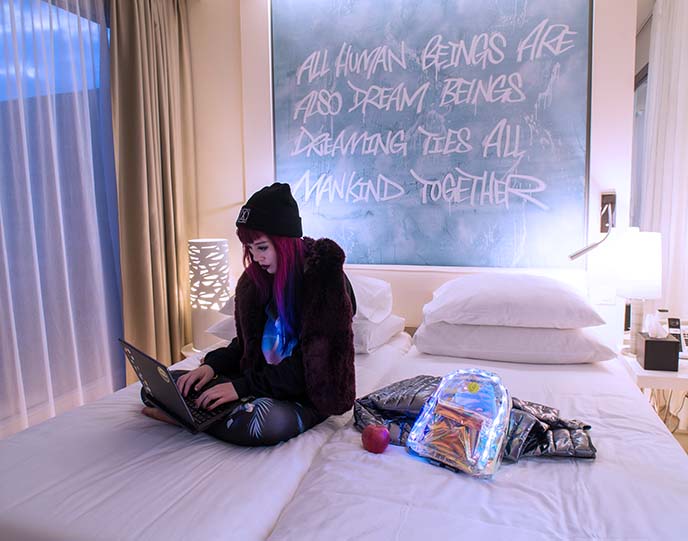
The hotel staff spoiled us with gifts of Swiss chocolates and Sephora spa products. I made myself at home, cozying up with my laptop and fiddling with the Philips Hue color wheel (which changes the mood lighting).

The rooftop terrace gave us a chance to play around with long-exposure photography. I created a heart shape using my light-up Cyberdog backpack!
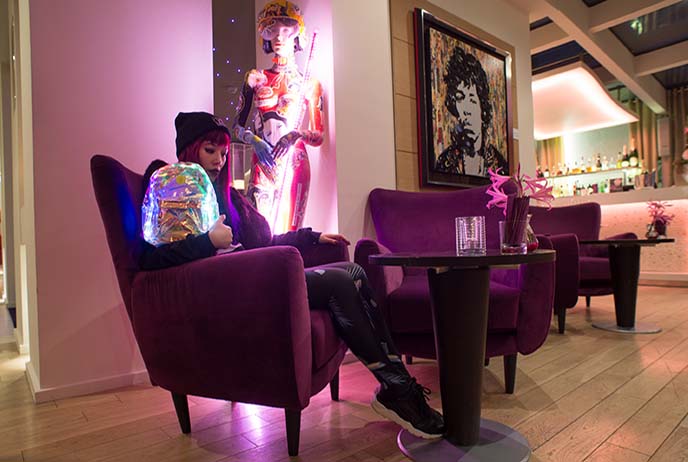
Hotel N’vY’s name is a play on “envy,” since your friends will be jealous once they see photos of this hip hotel. The lobby’s decor is a tribute to music with portraits of Jimi Hendrix and The Doors, and a wall of electric guitars.

Walking around, you feel as if you’re in a pop-art exhibition. The sculptures add to the trendy, bold design of the bar and lounge area.
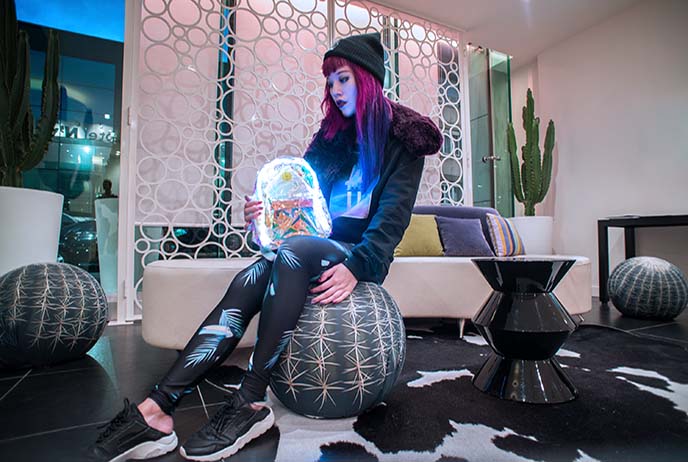
Ouch, that cactus-chair looks like it hurts! Hotel N’vY is a great fit for millennial and design-loving travelers.

My futuristic outfit matched David Cintract’s “Pop Libre” mannequins: women in helmets and heavy makeup, holding glowing synth-sticks.

Time for dinner at the hotel’s Restaurant Trilby, named after the fedora hat worn by many artists. I began with the limited-edition fall cocktail, a bowl of warm spices like cinnamon and cloves.
To start, we ate up every bite of the salmon tartar with mango, and scallops and leeks ravioli. The European fine-dining menu included steaks and sole meuniere, paired with outstanding French wines. We finished up with chocolate fondant and pear chocolate tart, two superbly made desserts.
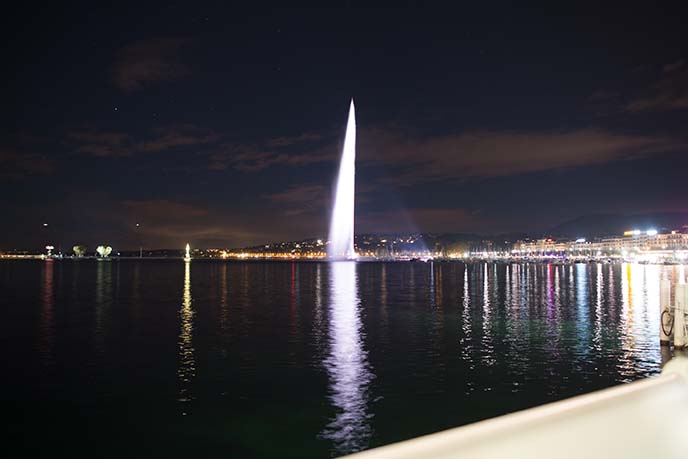
We walked off the meal with a stroll around Lake Geneva. It’s impossible to miss the Jet d’Eau. First installed in 1886, the fountain launches 500 liters of water per second, to the height of 140 meters (460 feet).

Geneva is filled with stately fountains and classic architecture. We enjoyed strolling through this park on the way to St Pierre Cathedral.

I leave you with a final glowing shot of my Cyberdog backpack. Merci Hotel N’vY for the arty, cozy, trendy stay in the heart of Genève.
How about you; what do you have in your winter wardrobe? Don’t forget to take a minute to watch my footage from the Dance with the Dead concert, and the Cyberdog video that went viral.



 LA CARMINA
LA CARMINA






